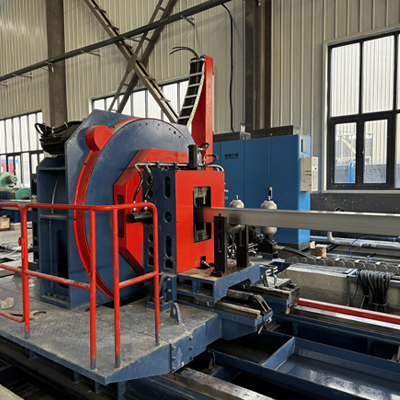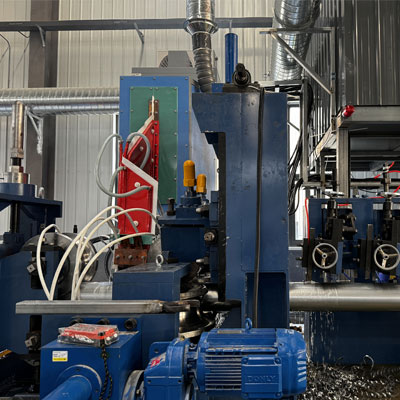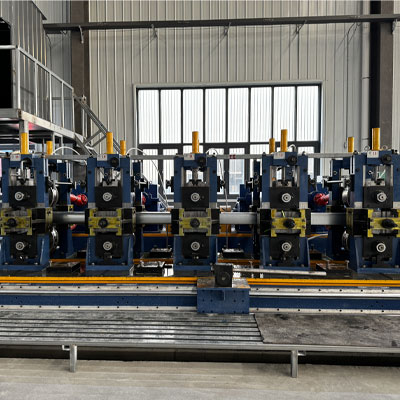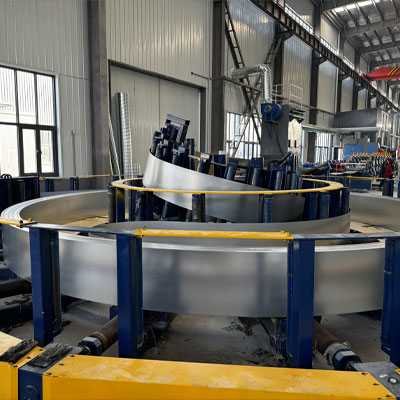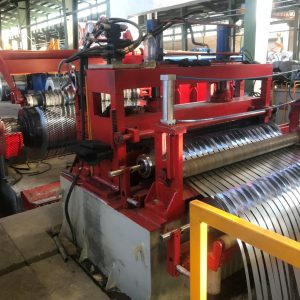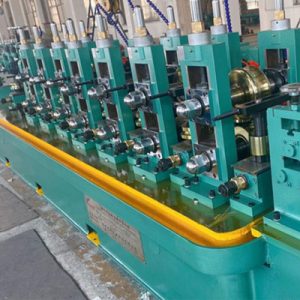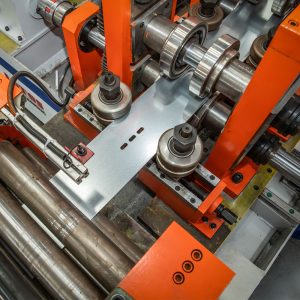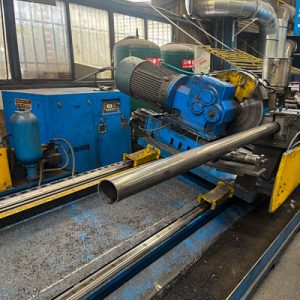Product description
Technical Proposal :
1. Coil Charging Car:
Structure Type:
The single head uncoiler is responsible for securely holding the steel coil in a fixed position and gradually feeding the strip in a controlled manner toward the subsequent production line equipment. This device locks the coil firmly in place by applying uniform internal pressure and regulates the strip’s uncoiling speed through a brake or motor, ensuring synchronization with the line’s requirements to prevent sudden tension changes, strip loosening, or misalignment. Unlike double head uncoilers, which allow simultaneous loading of two coils and quick coil changes, the single head uncoiler features a central mandrel and accommodates only one coil in the production process at a time. This design is highly suitable, cost-effective, and easy to operate for lines that require fewer coil changes or operate at medium production capacities.
2. Shear And Butt Welder:
The shearing and butt-welding system ensures precise and orderly joining of two steel sheets. After welding, the joint seam is leveled and smoothed, and the supplied strips are prepared for the accumulator.
The maximum weldable thickness of this system is 6mm, allowing for the joining of mediumthickness steel sheets. The welding speed of 500mm/min provides an optimal balance between weld quality and production efficiency, enabling continuous and uniform welds in a short time.
The Submerged Arc Welding (SAW) process is an automated welding method where an electric arc is established between a continuously fed wire electrode and the workpiece, under a protective layer of flux powder. This flux prevents the molten metal from contacting the air, stabilizes the arc, and reduces spatter, thereby improving weld quality. The concentrated heat of the arc ensures deep and uniform penetration of the weld metal in the butt joint. Key parameters such as current, voltage, wire feed speed, and welding travel speed are precisely controlled to achieve an optimal metallurgical structure and high mechanical properties.
3. Horizontal Accumulator:
Accumulator: 1 set
• Drive method: Feeding Motor → Universal joints → Carbide-faced
cylindrical gear decelerator with lubrication oil pump → Open gear →
Basket.
• Feeding Motor: YCT250-4A, 18.5 kW
• Driven Motor: YCT250-4B, 30 kW with a speed regulating system using
an INVERTER.
• Basket Diameter (OD): Ø6500 mm
• Run-out Speed: Max 200M/min
• Equipped with safety fence for motors and accumulator loop
4. Forming Machine
| Description | Item | Technical parameters |
Horizontal-roll stands | Quantity | Six stands |
| Material of horizontal stands | High-precision forged steel | |
| Diameter of horizontal shaft | Φ120mm | |
| Material of horizontal shaft | 42CrMO | |
Vertical-roll stand | Quantity | seven stands |
| Material of vertical stands | QT50 | |
| Diameter of horizontal shaft | Φ80mm | |
| Material of horizontal shaft | 45# forged steel | |
Driven gearbox | Quantity | Six gearboxes |
| Material of gearbox | QT50 | |
| Type | Spiral bevel gear | |
| Material of gearbox | 20CrMnTi | |
| Material of shaft | 40Cr | |
| Power transmission method | From universal transmission joint to horizontal roll stands |
5. Roller Stands with Carriage System for Front Horizontal Stands in Forming
and Sizing Sections (easy change):
This system includes two sets of roller stands mounted on movable carriages (or trolleys):
• One set for the Forming section
• One set for the Sizing section
These stands are installed on rails or wheeled carriages, allowing for smooth and controlled
movement of the roller assemblies.
Advantages:
1. Reduced roller changing time and increased production capacity:
With carriage-mounted roller stands, there’s no need for time-consuming manualdisassembly.
The entire roller unit can be shifted easily, minimizing machine downtime and enhancing throughput.
2. Prevention of bearing damage and extended equipment lifespan:
In conventional setups, manually pulling out the roller frame can place excessive stress
on bearings, leading to premature wear or failure.
The carriage system enables smooth and uniform movement, significantly reducing stress
and potential damage to mechanical components.
3. Improved alignment and accuracy:
Carriage-mounted rollers can be positioned with high precision, ensuring better
alignment during tube forming and sizing processes.
4. Enhanced maintenance and safety:
Simplified access to the rollers facilitates maintenance and reduces the risk of worker
injury compared to manual frame handling.
6. Welding Section
500KW – Solid State IGBT High Frequency Welder
1.1 Main Parameters:
• Rated Output Power: 500 kW
• Rated DC Voltage: 235 V
• Rated DC Current: 2500 A
• Overall Efficiency: η ≈90%
• Output Frequency: f=200-250kHz
• Resonance Type: Compound Resonance
• Tank Circuit Output: No welding transformer output.
• Ripple Factor: < 0.5%
• Welding Method: Induction Welding
• Power Supply Capacity: 600kVA
• Input Voltage: 3-phase, 380 V / 50 Hz, 4-wire system
• Rated Input Current: 911A
Cooling System (Soft Water Circulation – Air-Water Type):
• Operating Water Pressure: 0.32 MPa
• Water Flow Rate: 50 m³/h
• Cooling Capacity: 175 kW
2. System composition:
The solid-state high frequency all-in-one welder consists of four main parts:
IGBT high-frequency inverter with PWM voltage regulator,
High-frequency transformer,
High-frequency rectifier using FRED fast recovery diode module,
E-bridge inverter output.
AC voltage regulation with PWM is integrated into a single control board. The PWM control
unit is embedded on the main board, with its main functions managed by a single-chip
microcomputer and PWM control system. Voltage adjustment and feedback control are achieved
through the dual closed-loop PI regulator on the main board.
Alarm and protection control are based on a digital circuit as the control core, combined with
fast-response hardware, ensuring sensitive and precise protection actions.
This welder uses a full-wave rectification and IGBT inverter regulation mode, eliminating the
need for phase angle control used in older systems. As a result, it offers high power factor,
energy-saving performance, and reduces the cross-sectional area required for input cables.
Solid state HF welder is designed for continuous working. Rectifier inverter integrated
structure, compact size easy to install. The whole set of equipment achieves the function
of equipment linkage control and diagnosing faults by PLC system. The working statue
is observed by LCD display.
Inverter adopts E bridge structure. The main power parts are IRFP460 from IR Company
and DSEI60-06A fast recovery diode from IXYS Company in US, which are composing
current inverter.
The output power of single layer power module is 50KW, the equipment are parallel
connected by multilayer power modules. The rated work frequency is 400KHz. The same
power module is interchangeable. This power module can work steadily in 600KHz,
therefore it can work in 400KHz easily. The technique of the equipment is well proven.
3. Performance and Efficiency Gains with IGBT Inverter Technology:
1. High Energy Efficiency:
IGBT modules offer low switching losses, enabling system efficiency greater than
90%.
2. Stable Output and Consistent Weld Quality:
Precise voltage and frequency regulation via PWM ensures steady operation and
uniform weld seams.
3. High Power Factor and Reduced Energy Consumption:
The use of full-wave rectification and elimination of phase-angle control significantly
improves power factor and reduces electrical losses.
4. Compact System Design:
IGBT inverters eliminate the need for bulky phase-control components, resulting in a
more compact and space-saving layout.
5. Reduced Input Cable Size:
Due to stable current draw and improved power factor, smaller input cables can be
used, lowering installation costs.
6. Enhanced Reliability and Low Maintenance:
Solid-state construction with no moving parts increases operational life and minimizes
maintenance requirements.
7. Advanced Digital Protection Compatibility:
Fully compatible with fast-response digital protection systems, ensuring precise fault
detection and improved operational safety
4. Main Components List:
| Name | Model | Manufacturer |
| IGBT | FF450 | Infineon |
| MOSFET | IRFP460 | IR Co.IR |
| Quick recovery diode | DSEI60 | IXYS Co.IXYS |
| Resistance | 25R | Austria |
| Tank circuit capacitance | CS | Domestic famous brand |
| PLC | SR30 | |
| Human interface | Kunluntongtai | |
| Switch power supply | Taiwan Minwei Co. | |
| Air-Cooling System | FS series F-S | Domestic famous brand |
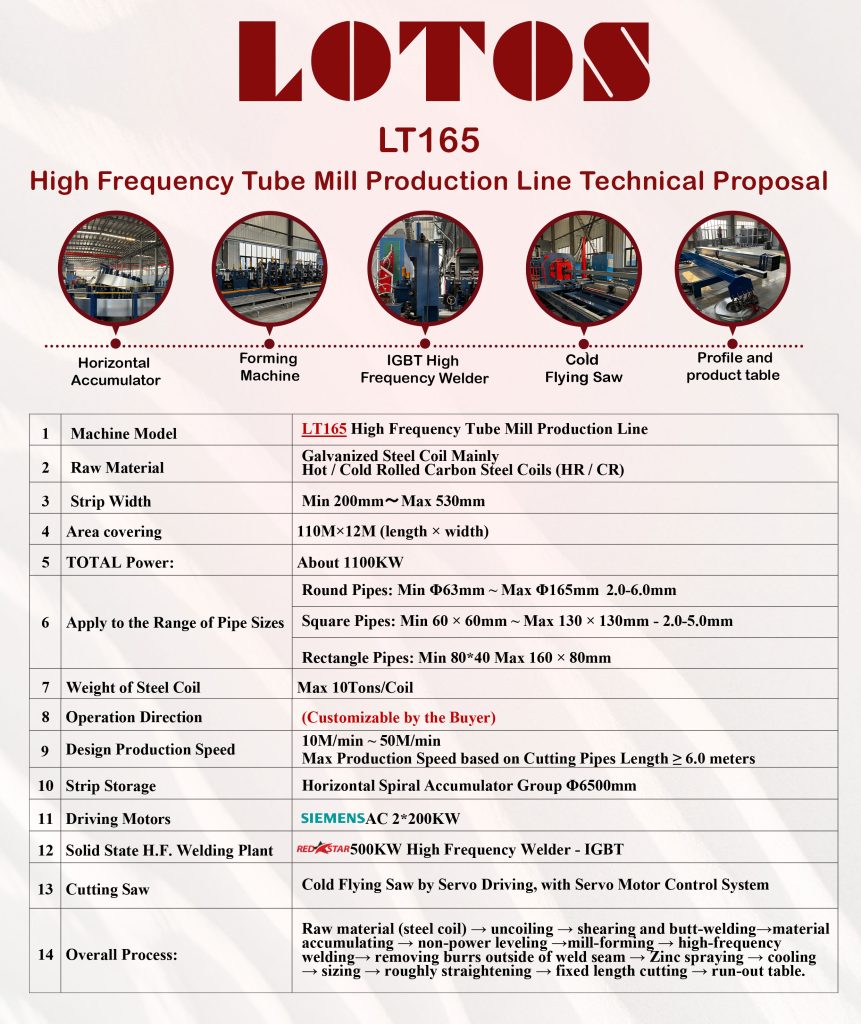
7. Scraper Frames:
Function:
Two sets of scraper frames are installed to remove the external weld bead formed
after the HF welding process. This operation enhances surface quality and prevents
interference in subsequent processes like coating or sizing.
Design Features:
• Each frame is equipped with an
adjusting pole for precise positioning.
• Includes a quick feed-in and feed-out
mechanism, allowing fast and efficient
changeovers during production shifts.
• Facilitates easy maintenance and
adjustment based on pipe diameter and
• weld bead profile.
| Component | Technical Specification | Remarks |
| Guide Type | Turkish-heads guiding system with 360° rotary adjustment | Enables precise seam alignment |
| Welding Rolls | Two or three squeeze (welding) rollers | Selection depends on pipe size and weld load |
| Scraper Stands | Equipped with adjustable pole and quick feed-in/feed-out system | Allows rapid setup and precise bead removal |
8. Zinc Spraying: Repairing the Welding Seam Zinc Surface:
PT- 400A Arc Spray Device Technical Specifications:
| Item | Specification |
| Power supply | Three-phase, 380V – 50Hz AC |
| Input power | 18.5 KVA |
| Input current | AC 22A |
| Adjustable output voltage | DC 20–46V |
| Output current | DC 400A |
| Load efficiency | 60% |
| Insulation class | Class F |
| Voltage adjustment steps | 10 steps |
| Power supply type | Constant voltage |
| Dimensions (L × W × H) | 760 × 500 × 960 mm |
| Weight | 120 kg |
| Required compressed air pressure | More than 0.6 MPa |
9. Cooling type: Sink and shower:
Cooling Type: Sink and Shower refers to the cooling system designed to manage
and dissipate heat in industrial applications. Specifically:
• Sink Cooling: This involves using a cooling sink or heat sink, which absorbs
and dissipates heat from high-temperature components, often through
conduction. It helps maintain the optimal temperature of critical parts during
the production process.
• Shower Cooling: This method uses a shower-like mechanism, where water
or a cooling fluid is sprayed or flowed over the surface of the components to
directly absorb heat. It’s commonly used for rapid cooling and temperature
regulation in various industrial processes.
Together, these two cooling methods ensure effective heat management, preventing
overheating and enhancing the operational efficiency of machinery or production lines
| ||||||||||||||||||||||||||||||||||||
11. Roughly Straightening Machine Frame:
The roughly straightening machine frame is a crucial component in the pipe
production process, specifically designed to correct initial shape irregularities in the
pipe. After the forming process, the pipe may have slight bends or distortions that
need to be corrected to ensure the pipe is straight and dimensionally accurate. The
roughly straightening machine is responsible for this initial correction.
• Structure: The machine frame typically consists of multiple rollers or guides
that apply pressure to the pipe, straightening it along its length. The frame is
robust and built to withstand the stresses of straightening without deforming
or causing any additional damage to the pipe.
• Operation: The pipe is fed through the straightening machine, and the rollers
exert force on the pipe to straighten any bends or twists. This process ensures
that the pipe is as straight as possible before it moves on to the next stage in the production line.
• Purpose: The primary purpose of the roughly straightening machine frame is
to prepare the pipe for further processing, such as sizing, finishing, or coating.
Straightening improves the overall quality of the pipe, ensuring it meets
industry standards for straightness and is suitable for its intended application.
Technical Parameters:
• Straightening Stands Type:
4 Turk’s head type, with 360
rotary capability
• Diameter of Straightening
Shaft: Φ35mm
• Material of Straightening
Shaft: 40Cr
This machine is essential to
ensure that the pipe has the necessary geometric properties, particularly
straightness, which is critical for maintaining the structural integrity and
functionality of the pipe in its final application.
12. Cold Saw Automatic Tube Mill 165:
Description:
The Cold Flying Saw is an advanced solution for
high- speed HF welded tube and pipe production
lines, enabling continuous cold mechanical
cutting without stopping the line or generating heat.
The cutting head, mounted on a linear guide and
driven by servo or hydraulic actuators,
synchronizes with the moving tube. A highperformance circular blade (alloy steel or
carbide) then executes a precise cut before
returning for the next cycle.

